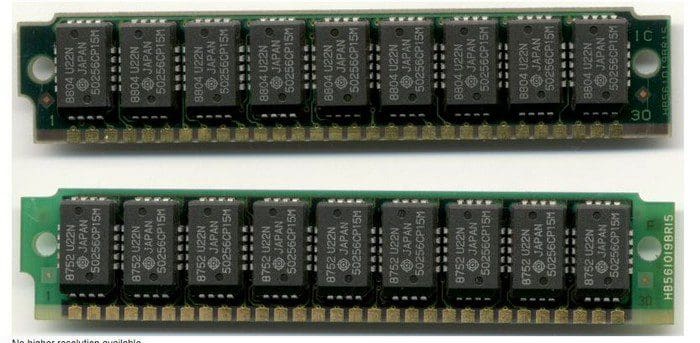Modern computers need to have RAM installed on RAM sticks. These sticks are called DIMMs because all of the electrical pins are in line, and there are two lines of them, leading to the acronym Dual In-line Memory Module. This wasn’t always the case, though, as DIMMs were invented in the 1990s.
DRAM History
Really early in the development of computers, RAM chips were installed directly on motherboards as integrated circuits using DIP sockets. Because many chips were needed, a lot of space was taken up. The Single In-line Memory Module or SIMM was designed to free up most of that space. The memory chips were installed on a separate circuit board and plugged into the motherboard at a perpendicular angle.
The first generation of SIMMs used electrical pins that went into sockets like a large SIP chip. This design, however, was vulnerable to the pins being bent, and the pins were the most expensive part of the SIMM. To reduce costs and increase the integrity of the connectors, the pins were redesigned to be edge connectors. These edge connectors are still used in modern DIMMs, albeit with some modifications.
The thing about these new edge connectors was that they went over the whole bottom edge. Each connector pad ran over the SIMM’s front, bottom, and back. The overall number of connectors didn’t change, just the type. This is the key difference between SIMMs and DIMMs. On SIMMs, the connectors are redundant on either side because they’re really one pin. The connectors on DIMMs are different on each side, doubling the pin count with no extra effort.
Note: Slightly confusingly, these edge connectors are still generally referred to as pins.
Increased Pin Count
Each pin can only transmit one of two potential values each clock cycle, on or off, the binary 1 or 0. Adding more pins means more data can be transmitted per clock cycle, increasing the bandwidth. Not all of the pins go into improving the actual I/O bandwidth of the SIMM. A range of pins is used to issue commands to the RAM too.
When CPUs process data, they need that data to be in the CPU cache. That cache is significantly faster than RAM but much more expensive, so there’s not much of it. So, data is stored in RAM and then copied to the cache when needed. To efficiently do so, the memory bus is designed to be broad in that it has as many connections as possible. This means that as many bits as possible can be transmitted per clock cycle. Modern computers have a 64-bit memory bus, but in the early 80s, when the SIMM was invented, the memory bus was 8-bits wide. 8 pins were used to transmit data per clock cycle, while the rest of the 30 pins on a SIMM were used to send commands.
As CPU development continued, the memory bus width was increased to 16-bits. The problem is that with only 8 data pins, only 8 bits of data can be transferred per clock cycle. SIMMs were paired up to get around this, providing 16 data pins to fill the memory bus. Of course, CPU development didn’t stop there, and the 32-bit memory bus soon came along. While some systems allow for four 30-pin SIMMs, a new standard was released with a 72-pin SIMM with 32 data pins.
Losing out to DIMM
With the arrival and quick market acceptance of the Intel Pentium P5 with its 64-bit memory bus in 1993, and CPUs with 64-bit memory busses, the same game had to be played. While some systems supported dual 72-pin SIMMs, a new form factor took the lead, DIMM. With twice the number of pins on one stick of RAM, DIMMs were cheaper (at least when compared to two SIMMs) and used less space on the motherboard.
Eventually, the DIMM form factor became the standard, and SIMM dropped out of use. Essentially nothing still uses SIMM now. Indeed no new hardware. However, there are almost certainly legacy devices still running it somewhere. DIMM is still used today and is unlikely to go anywhere soon.
Conclusion
SIMM was the original form factor for the memory stick. They made upgrading or installing RAM a lot easier by making it a single process, rather than needing to plug in the 8 DRAM chips by hand. Using pins and then keeping the edge connectors as single contiguous pins eventually led to their replacement by DIMMs in the early 90s.
This doubled the connector pin count by separating the pins on each side of the RAM stick. SIMMs have essentially been entirely replaced by DIMMs with no new products in around a quarter of a century. What are your thoughts on the subject? Share your thoughts in the comments below.




